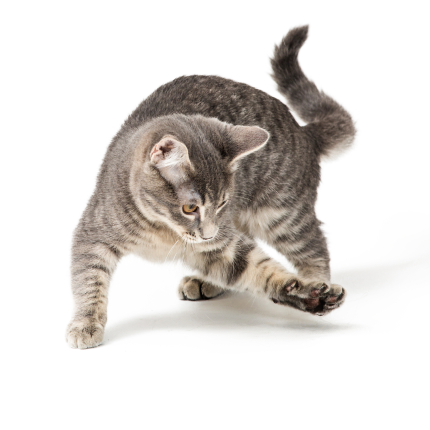Frenetic Random Activity Periods: AKA Cat ‘Zoomies’

If you’ve ever witnessed your usually calm cat darting across the room with boundless energy, you’ve encountered what’s scientifically termed a frenetic random activity period (FRAP). Some might affectionately refer to these episodes as “the zoomies” or “the midnight crazies.” Regardless of the name, these bursts of hyperactivity, while surprising, are typically brief and don’t usually indicate any serious health issues.
Understanding FRAPs in Cats
Frenetic random activity periods manifest as sudden bursts of energy that prompt cats to engage in seemingly erratic behavior. Your cat may run in circles, leap from furniture, or race up and down the stairs before abruptly halting the activity.
Both cats and dogs experience FRAPs, but certain triggers may differ between the two species. Dogs often exhibit FRAPs after periods of low activity, such as waking from naps or spending time in a crate. In contrast, cats typically experience FRAPs during dawn and dusk, though they may occur at any time, often triggered by activities like grooming or using the litter box.
Causes of Frenetic Random Activity Periods
Instincts: In most cases, FRAPs are a normal expression of a cat’s natural instincts. Similar behaviors are observed in various animals, including wild species like elephants and domestic pets like ferrets and rabbits. For rabbits, FRAPs, known as “binkies,” are associated with heightened excitement. These episodes allow cats to exercise their predatory instincts and simply have fun.
Behavioral Issues: While usually harmless, frequent or intense FRAPs may sometimes indicate underlying behavioral issues such as anxiety or stress. If you notice changes in your cat’s behavior or demeanor, it’s essential to consult with your veterinarian.
Health Concerns: Occasionally, late-night FRAPs may signal health problems like hyperthyroidism, especially in older cats. If you observe an increase in FRAP frequency or intensity, a visit to the vet is warranted.
Managing FRAPs
Since FRAPs are typically natural and short-lived, most cat owners need not intervene. However, it’s crucial to cat-proof your home to prevent accidents during these episodes. Investing in pet insurance can provide financial protection in the event of injuries.
What Not to Do
- Avoid chasing your cat during FRAPs, as it may encourage further frantic behavior.
- Refrain from scolding or punishing your cat, as this can exacerbate stress and anxiety.
- Instead, focus on providing a safe environment and engaging in regular exercise to help alleviate excess energy.
Living with FRAPs is a normal aspect of cat ownership. By understanding these behaviors and taking appropriate precautions, you can ensure a happy and healthy life for your feline companion.

Featured Articles

Why Do Cats Roll Over Into Their Backs But Not Let You Touch Their Bellies?
It’s common knowledge dogs love to have their tummies rubbed when they freely lay down before you and roll onto their backs. But, if you’re also familiar with cats, you know that when they roll onto their backs with their bellies exposed, rubbing the belly will most likely result in…

Greebles and Cats: The Origin and the Meaning
You may have seen an internet sensation concerning cats labeled “greebles.” Feel out of the loop? We’re here to help you. In 2019, Reddit user /user/literallyatree commented on a Reddit post about a cat that looks like it’s trying to slap a ghost. This user commented: “My family calls things…

Polydactyl Cats: Just More Beans to Love
Polydactyl cats have become extremely popular in recent times. As a result, more and more people are interested in learning more about this six-toed cat and want to get one of their own. If you are a cat lover intrigued by polydactyl cats, you have come to the right place….